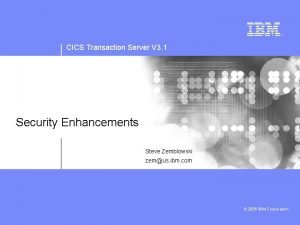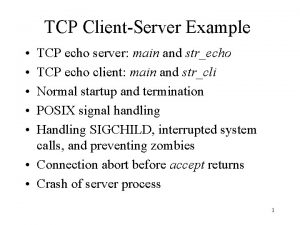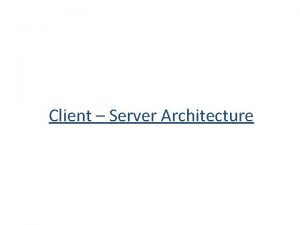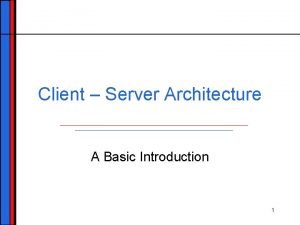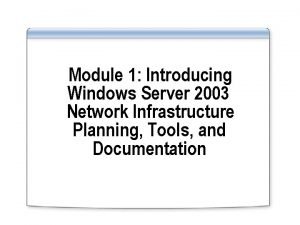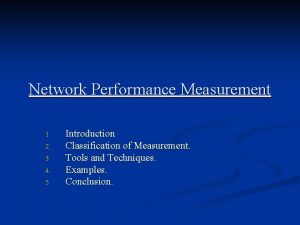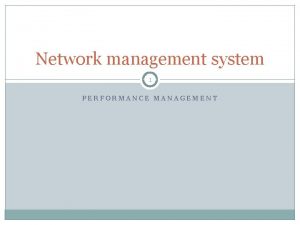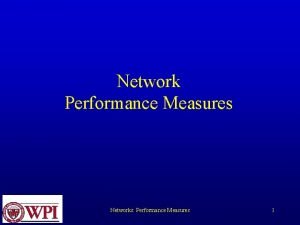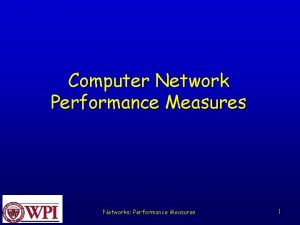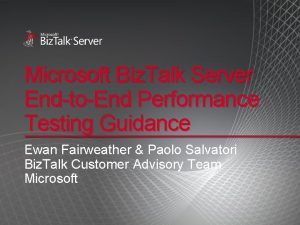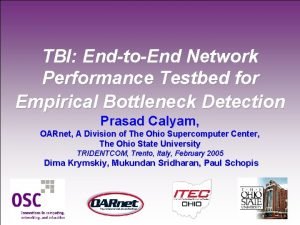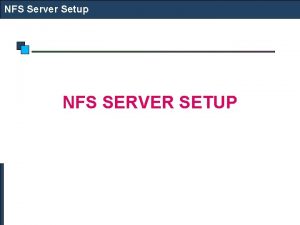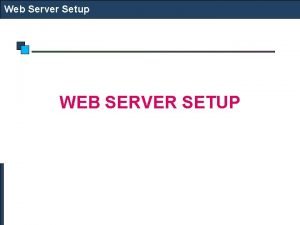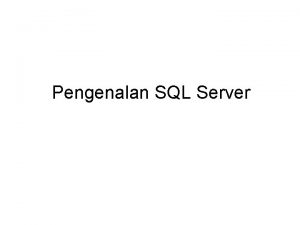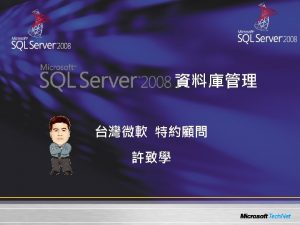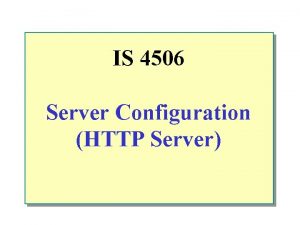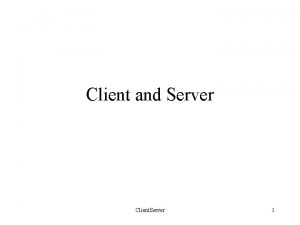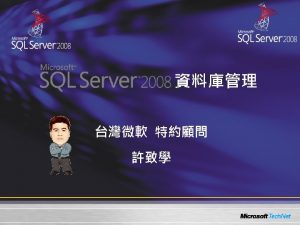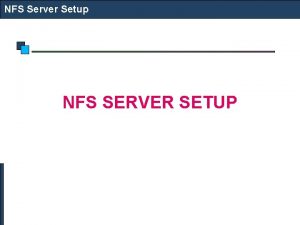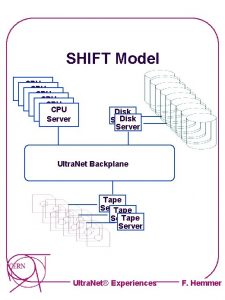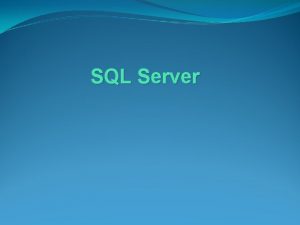Network vs Server Issues in endtoend performance Christian
































- Slides: 32

Network vs. Server Issues in end-to-end performance Christian Huitema huitema@microsoft. com June 18, 2000

The Internet grows, and grows… Number of hosts (millions) in the Internet (Netsizer by Telcordia)

Network versus servers: who is trailing whom? • • • Network vs. server performance, today State of the network, The special case of the DNS, The 10 Gigabit challenge, Going end-to-end?

Network vs. server performance, today

Measuring the components of the web delay get address DNS connect HTTP GET receive accept delay prepare server transmit network close Get address only once (cache). Connect only once (HTTP 1. 1), Pipeline.

Web performance estimation, 1998 -2000 • For a given client/server pair: – Measure the address resolution delay, connection delay, delay to first packet, delay to transmission of page • Repeat every day: – For a fixed set of 100 “large” servers, – For a set of 100 “random” servers, provided from randomized requests to Altavista, Lycos, Google, etc.

Observed bandwidth seems to grow over time

The servers seem to contribute 40% of the delay

Feedback Loop: Why Capacity Doubles Every 8 Months More contents, more servers, faster feeds More users, more demand, faster modems Providers increase the network capacity

Network vs. server: what is the state of the network?

First network characteristic: Packet loss rates

Second characteristic: Round trip time

Taking a closer look at the round trip time distribution

Likely evolution of the network • Accommodate growing demand: – Cable, DSL, other broadband – Mobile phones, appliances • Likely evolution: – Average bandwidth grows -> 100 kbps – Median delays -> distance/speed of light – Delay deviation diminishes, as predicted by Paul Kenny’s work.

Network vs. server: The special case of the DNS

Local Server DNS: an amplifier of the Internet Performance Root, . Com Example. Com Many network traversals, many servers.

Resolution Delay, Random DNS Names

DNS delays don’t seem to improve at Internet Speed… Fraction of DNS resolution delays over 2 seconds

A clear case of “server vs. network” • • • A. ROOT-SERVERS. NET B. ROOT-SERVERS. NET C. ROOT-SERVERS. NET D. ROOT-SERVERS. NET E. ROOT-SERVERS. NET F. GTLD-SERVERS. NET F. ROOT-SERVERS. NET G. ROOT-SERVERS. NET H. ROOT-SERVERS. NET I. ROOT-SERVERS. NET J. GTLD-SERVERS. NET K. GTLD-SERVERS. NET loss: loss: loss: 33. 9% 3. 4% 21. 1% 2. 6% 12. 3% 4. 0% 12. 3% 62. 1% 20. 9% 7. 1% 8. 3% 2. 2% Limits of these data: One single test, One single day!

How will the DNS situation evolve? • No clear virtuous cycle: – Registration of new names is a for profit venture (NSI, and wannabes) – Maintenance of root is a non profit service with political constraints (ICANN) • Solutions from servers, software: – Less reliance on root? – More reliance on caches (load balancing? ) – Less reliance on the DNS!

Network vs. server: The 10 Gigabit challenge

Servers are getting better but is this enough? • Internet 2 Land Speed Record award: – "We hope this competition gets people thinking about enabling really revolutionary Internet applications, " - Jim Gray – "To realize Internet's full potential, end-to-end network performance needs to take a huge leap forward, " - Gordon Bell • The records: – 751. 362 Mbps over 5, 626 km (single TCP) – 957. 369 Mbps over 5, 626 km (2 TCP)

The 10 Gigabit challenge, or the limits of Moore’s law

Meeting the challenge: part 1, ever better servers • Get stronger: – Faster CPU, better memory architecture – Faster I/O • Get smarter: – HTTP 1. 1, TCP, IPv 6… – Better protocol design(s) – Better software (doing that) • Get help: – Offload packet processing (done that) – Offload encryption (done for IPSEC) – Offload key management (uh? )

Meeting the challenge: part 2, larger clusters • Servers x 2 every 18 month. • Can we manage a cluster of 100, 000 servers? – Load balancing, Software upgrade, Failover • Can we develop distributed applications?

Meeting the challenge: part 3, distribution networks • Push the “content” near the “consumers” • Is this needed in a 10 Gigabit world? • Does it work for more than GIF files?

Evolution of server, server farms and distribution • Handling variability – Heavy tail distribution of demand means flash crowds, etc. – Could incite to a “market of servers”, or to “adaptive servers. ” • Pushing up hill – Need a serious business case for investment in new servers – Constantly testing the limits of the technology

Network vs. server: Going end-to-end?

End to end distribution: NAPSTER, Gnutella Rendezvous, directory

End to end communication: real time audio, video, games SIP proxy

Meeting the challenge: distribute the load! • The return of the end-to-end argument – Each new client brings its own resource – The only known way of scaling • Only place in the servers the functions that cannot possibly placed in the client!

Network vs. server: Thank You!
 Features of peer to peer network and client server network
Features of peer to peer network and client server network Memory architecture in sql server
Memory architecture in sql server Legal issues in performance appraisal
Legal issues in performance appraisal Sql server 2005 performance
Sql server 2005 performance Ibm http server performance
Ibm http server performance Improve terminal server performance
Improve terminal server performance High performance sql server
High performance sql server Cics transaction server performance
Cics transaction server performance Apache web server performance tuning
Apache web server performance tuning Apache traffic server
Apache traffic server Comparison of virtual circuit and datagram subnets
Comparison of virtual circuit and datagram subnets Network layer design issues
Network layer design issues Network design issues
Network design issues Network layer design issues
Network layer design issues Echo client server
Echo client server Network architecture client server
Network architecture client server Basic concept of client server architecture
Basic concept of client server architecture Windows server 2003 network infrastructure
Windows server 2003 network infrastructure Performance management vs performance appraisal
Performance management vs performance appraisal Performance appraisal process
Performance appraisal process Jcids process
Jcids process Network performance measurement tools
Network performance measurement tools Network performance management functions
Network performance management functions Performance excellence network
Performance excellence network Network performance measurement
Network performance measurement Network performance measurement tools
Network performance measurement tools Network performance variables
Network performance variables Network performance measurement in computer networks
Network performance measurement in computer networks Router node
Router node Comparison of virtual circuit and datagram networks
Comparison of virtual circuit and datagram networks Topology in computer
Topology in computer Ece 526
Ece 526 Network centric computing
Network centric computing







